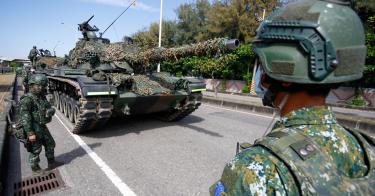Policymakers often assume the United States can deter China from invading Taiwan or win if deterrence fails. But that is no longer a safe assumption. Indeed, it is very possible that the United States will be unable to deter China for the remainder of this decade. Worse still, there is a real chance the People’s Liberation Army will be able to defeat U.S. forces in a fight over Taiwan.
We are in this situation because Washington has consistently failed to prioritize investing in our ability to deter China. But now we have no other choice: If we wish to avoid war with China, or prevail if it comes, then we must urgently focus on strengthening deterrence in the Indo-Pacific by surging investments in the region, even if it means doing less elsewhere. This may not be the choice Washington wants to make, but we have spent decades deferring these investments—and now the bill is due.
America’s Deterrent Has Weakened—But Few Realize How Bad It Is
The Trump and Biden administrations rightly identified China as the greatest threat to American interests. The Chinese Communist Party seeks hegemony in the Indo-Pacific. If it succeeds, it will have control over the world’s largest market zone, with dire implications for Americans’ security, freedom, and prosperity. To deny Beijing’s ambitions, however, we must be able to prevent it from using military force to dominate its neighbors. Most urgently, this requires strengthening deterrence against a Chinese invasion of Taiwan, which the Department of Defense (DoD) has designated as its “pacing scenario.”
>>> Winning the New Cold War: A Plan for Countering China
It is no secret that America’s ability to deter China has eroded, but the severity of that erosion is not widely understood. Fortunately, this is starting to change. In 2019, the United States Studies Centre reported, “America’s military primacy in the Indo-Pacific is over and its capacity to maintain a favourable balance of power is increasingly uncertain.” Last year, The Heritage Foundation’s Index of U.S. Military Strength concluded, “[T]he U.S. military is at growing risk of not being able to meet the demands of defending America’s vital national interests.” The RAND Corporation found similarly this year: “[I]t has become increasingly clear that the U.S. defense strategy and posture have become insolvent.”
Things are especially dire in the Pacific. The Trump and Biden administrations both embraced a strategy of denial to deter China. This strategy rests on our ability to prevent China from successfully invading Taiwan, especially by quickly disabling or destroying hundreds of Chinese ships in the invasion fleet. Yet it is not clear the United States can do this. As RAND found, “Neither today’s force nor forces currently programmed by the [DoD] appear to have the capabilities needed to” defeat an adversary like China that can “seize the initiative and move quickly to secure their principal objectives.” Instead, our existing approach “leave[s] open the possibility of a rapid victory by China.” To make matters worse, Commander of U.S. Indo-Pacific Command (INDOPACOM) Admiral John Aquilino testified this year that trends in the Indo-Pacific are going “in the wrong direction.”
Despite years of warning about U.S. force posture, for instance, U.S. forces remain concentrated at a relatively small number of major operating bases in Northeast Asia. This posture incentivizes China to strike preemptively before U.S. forces disperse. It also makes it easier for China to find and engage U.S. forces during a campaign. While the Biden administration has secured or improved access in Australia, Japan, the Philippines, and other nations, it is unclear when many of these locations will be ready for contingency operations. Nor is it clear whether hosts will restrict U.S. activities in their territories. Washington can sidestep some restrictions by doing more in U.S. territories, but construction in Guam and Tinian has long suffered from self-imposed regulations, supply chain issues, and funding delays.
Meanwhile, hardening, redundancy, deception, concealment, and rapid recovery are long-acknowledged complements to dispersal, but they, too, remain works in progress in the Indo-Pacific. And while DoD plans to improve missile defenses on Guam, it is unclear if they will be effective ;against all threats, including hypersonic weapons and saturation raids. It is also unclear how DoD will protect Guam from attacks by Chinese special operations forces. As America trudges along, however, China is forging ahead with its own hardening and dispersal initiatives. As Thomas Shugart wrote, “What is clear is that at-scale survivability improvements can be done…within the region. They’re just not being done by us.”
U.S. forces are losing ground in other areas, too. In the air domain, for instance, China’s air forces will enjoy a significant numerical advantage near Taiwan. At the same time, China’s increasingly capable threat sensors and post-processing capabilities, airborne early warning and control (AEW&C) aircraft, stealth fighters, and long-range air-to-air missiles might even allow Chinese air forces to see and shoot U.S. aircraft first effectively. U.S. forces might respond by taking advantage of better pilots, innovative concepts like “pulsed airpower,” or allied contributions like Australia’s E-7 Wedgetails, but they will still be limited by the aging U.S. AEW&C fleet, insufficiently long-range air-to-air missiles, and munitions shortfalls, especially at standoff ranges.
America’s navy is also in trouble. China’s navy is the largest in the world and rapidly growing, with highly capable surface combatants and large fleets of paramilitary and civilian vessels available for amphibious operations, counter-targeting, and targeting. At the same time, China’s dense network of sensors and strike assets will make it harder for U.S. aircraft carriers and other ships to operate near Taiwan, limiting their ability to help blunt a Chinese fait accompli. U.S. submarine forces are still better than their Chinese counterparts. Still, they may be unable to fully capitalize on their qualitative advantage due to potential torpedo shortfalls and constraints on the number of attack submarines in the Indo-Pacific, especially in the initial period of war. Other munitions shortfalls and the ongoing retirement of guided-missile cruisers, guided-missile submarines, and attack submarines will further limit the Navy’s ability to deliver sustained firepower against Chinese targets. And things will get worse before they get better, with the Navy expected to shrink in the near term and recent testimony suggesting it may still struggle to resource a Taiwan fight in subsequent years.
Things do not get easier outside of the air and naval domains. Space is widely recognized as a vital warfighting domain. However, according to public testimony, U.S. military space architecture is not resilient enough for a wartime environment and probably will not be until at least 2026. U.S. forces reportedly face a similar deficit in electronic warfare. According to Representative Don Bacon (R-NE), the United States has not fielded the “combat capability output that we need.” China also reportedly fields the world’s largest cohort of state-sponsored hackers, and recently publicized hacks by Chinese operators suggest the United States may not be able to count on an advantage in cyberspace either. Notably, any deficits in electronic or cyberwarfare will affect—potentially severely—U.S. forces’ ability to project power in the air, sea, and other domains as well. And none of this accounts for the logistics difficulties U.S. forces would face in a region defined by long distances and austere conditions, which would need to be overcome by sealift and air refueling fleets already facing readiness issues.
All the while, the nuclear shadow is darkening. China is investing heavily in its nuclear forces, including theater nuclear forces that can be used for operational effect. This will exacerbate the operational difficulties facing U.S. forces. For example, a Chinese nuclear attack on Guam could significantly impact U.S. forces’ ability to execute conventional operations in the Western Pacific. China’s expanding nuclear arsenal will also limit America’s ability to use nuclear coercion to offset a conventional military disadvantage, should U.S. leaders wish to do so.
“Everything Needs to Go Faster”
The challenges facing U.S. forces in the Indo-Pacific are severe, but they should not be seen as insurmountable. The United States may no longer enjoy superiority over China in most warfighting domains, but this kind of superiority is not strictly necessary. As Elbridge Colby has argued, our goal in a Taiwan contingency is essentially defensive, so we do not need to dominate the Chinese. We need only be able to prevent them from conquering Taiwan.
>>> 2023 Camp David Summit Strengthened Allied Cooperation Against Indo–Pacific Threats
However, the United States is not moving fast enough to achieve even this limited objective. This is largely due to a lack of prioritization: The United States simply has not invested adequately in deterring China. This year, for instance, the Biden administration’s defense budget left U.S. Indo-Pacific Command with $3.5 billion in unfunded priorities, while U.S. European Command had a mere $160 million in unfunded priorities. Nor has the administration shown any serious urgency in requesting or taking advantage of congressionally authorized funding for Taiwan military aid. Some in Congress, at least, have demonstrated leadership in authorizing military aid for Taiwan, but appropriators have been reluctant to fund it fully. This is despite the United States committing $113 billion in assistance to Ukraine since February 2022 and the Biden administration having just requested another $24 billion.
This is not the behavior of a nation on the brink of war—and potential defeat—against a nuclear-armed rival in the world’s most important region. As Admiral Aquilino put it: “Everything needs to go faster.”
Moving faster in the Indo-Pacific will require more forces, more funds, and more political capital. For instance, the United States can shift submarines, ships, aircraft, and certain ground units to the Indo-Pacific to strengthen our deterrent posture and rapid response capability. Additional resources would also help to accelerate the dispersal and hardening of operating locations; increase weapons production and stockpiling; accelerate the adoption and development f new capabilities that could make a difference in this decade; preserve relevant capacity by delaying submarine, ship, and aircraft retirements; intensify intelligence-gathering on Chinese forces, including any critical and targetable logistics vulnerabilities; and fully fund efforts to arm Taiwan with the weapons it requires to defend itself.
But substantial and sustained defense spending increases appear unlikely for the foreseeable future. Addressing the threat from China will, therefore, necessitate reallocating resources from other parts of the defense budget. This is the essence of prioritization, and it will require the United States to do less and rely on allies and partners more in other theaters. No doubt, this is a difficult choice. But Washington has spent years avoiding hard decisions. As a result, we face a real risk of war and even defeat in this decade. That is a risk we should not accept, but the only way to avoid it—or at least reduce it as much as possible—is to finally do what we should have been doing all along: prioritize deterring China.
This piece originally appeared in The National Interest https://nationalinterest.org/feature/case-urgency-against-china-206790?page=0%2C1





